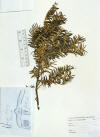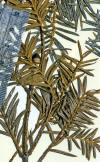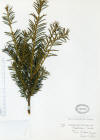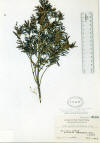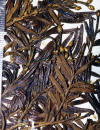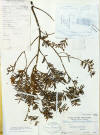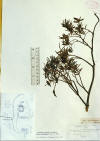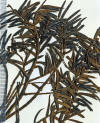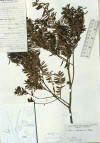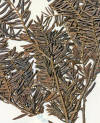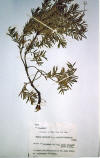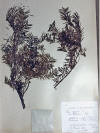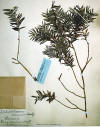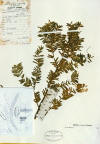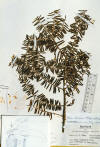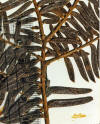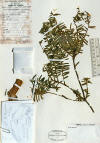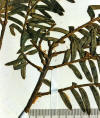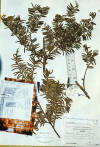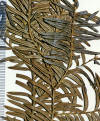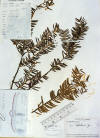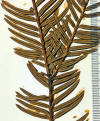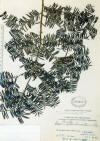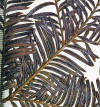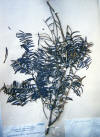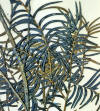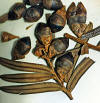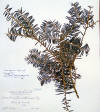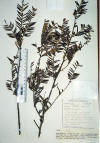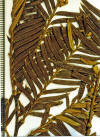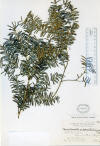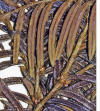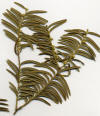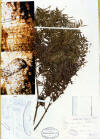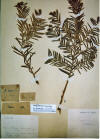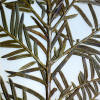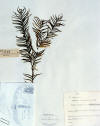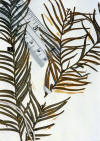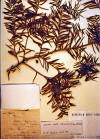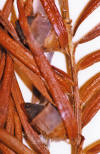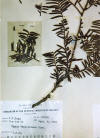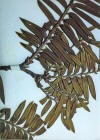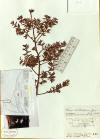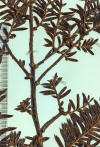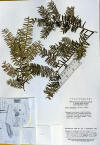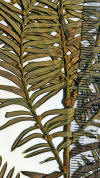| The Chinensis Subgroup is
characterized by leaves having a relatively narrow margin of smooth cells
along the abaxial surface, 4–12 cells wide, wider than tall epidermal
cells as seen in transverse section, and anticlinal stomata. In the northern range (central China), leaves of T. chinensis often lack papillae across 8–12 abaxial marginal cells, a feature that is common to T. umbraculifera (T. cuspidata Alliance). Also the reflexed leaves that characterize T. umbraculifera and its allies are occasionally seen in T. chinensis (e.g., Henry 7097 from W Sichuan). These shared characteristics suggest former contact between the species. In the southern range (Indonesia and the Philippines), the Chinensis Subgroup has more elliptically shaped epidermal cells as in T. sumatrana. The similarity between these species is also evident in leaf shape, texture, lack of epidermal papillae across 8–9 marginal cells. Taxus obscura (Chinensis Subgroup) is an example a species in the T. chinensis Subgroup that is similar to T. sumatrana of Taiwan in leaves having a reddish color along marginal and midrib epidermal cells, while also showing affinity to T. wallichiana in leaf arrangement, leaf length and in persistence and size of bud-scales. The anticlinal orientation of stomata is seen most frequently in specimens from Taiwan and Luzon. Stomata bands are further differentiated from adjacent epidermal layers by color. Specimens from mainland China, on the other hand, appear uniformly yellowish orange to reddish on the abaxial leaf surface in which stomata bands have both anticlinal and periclinal stoma. Stomata in the Sumatrana Group in contrast often appear alternate to each other along adjacent rows. Möller et al (2013) found evidence for a new species they described that would appear to belong this subgroup. They defined the species by the lack of abaxial midrib papillae and by the persistent bud-scales at the base of branchlets. But it is not clear whether midrib papillae are entirely lacking as leaves are often more papillose in the upper half in species of the Chinensis Subgroup. Their species does not appear to belong to the proposed T. ocreata and T. scutata (Hageneder 2007; Spjut 2001, 2007b, 2013) that have yet to be described. These species have papillose midribs, while none of the herbarium specimens cited by Spjut (3007a,b) were cited by Möller et al (2013). They provided an illustration of the type that closely resembles a T. chinensis shown from Hubei. Additional discussion on their new species as it may relate to species in the Sumatrana Group is presented under that group page. 6. Taxus chinensis (Pilg.) Rehder 7. Taxus obscura Spjut, J. Bot. Res. Inst. Texas 1(1): 235. 2007—Type: The Philippines. Luzon: Mt. Banahao, 2100 m, tree 8 m, common on ridge in mossy forest, aril bright red—26 Aug 1978, de Laubenfels P668 & P669 (holotype P-668, A! (Fig. 56, in adnot., T. phytonii var. obscura Spjut in ed.; with seed; leaf with 11 stomata rows/band, abaxial marginal border of 4 smooth cells across, in 2 quadrate rows and 2 inflated rows, trapezoidal, followed by 5–6 rows of papillose cells, midrib 15 cells wide, papillose on most cells, papillae covering the entire cell surface). Note: de Laubenfels P669 was collected from a male plant. Type also illustrated in de Laubenfels (1988). Arbor ad 15 m alta; ramis anisodichotomibus; perulae persistens, dessucatis- imbricatis, 3–4 seriatus, ovatis; Foliis 1–2 (-3) cm longis, 1.5–2.5 mm lati, acutibus, 0.200-0.300 mm crassis, supra convexa, subtus concava ad plana, supra cellulis epidermibus 20–25 µm altis, 25–35 µm latis, subtus rectangularis epidermibus inflatus proximus marginalis; ventralibus epidermis cellulis rectangularis, inflatus proximus marginalis, papillosibus interdum costas, bi-tertius e stomata zonas versus marginalis; papillae disposita media; stomata (10-) 11–13 (-15) seriata/zonas. Tree 5–15 m high; ultimate branchlets crowded, long, weeping or flexuous, yellowish green, dull rusty brown to orange with age; bud-scales occasionally persistent, or not evident, the scale scars at base of branchlets similar to those of T. chinensis, longest persistent scales ca. 1 mm long. Leaves often lost by the 3rd yr, spreading obliquely and overlapping in ± two ranks, frequently crisscrossing in herbarium specimens, especially near ends of branchlets, oblong, or slightly elliptical, recurved, evenly tapered to an acuminate sharply pointed apex, abruptly bent downwards to apex, 1–2(–3) cm long, 1.5–2.5 mm wide, 200–300 µm thick, dark olive green, resinous glossy and convex across adaxial surface to a recessed acute darker midrib with channels along each basal side, rugose in dried specimens; abaxial surface slightly concave across to a slightly elevated midrib. the midrib rounded to truncate, flush or slightly elevated, plane to abruptly revolute near margins; upper adaxial epidermal cells in transverse section broad elliptical to nearly short rectangular, thin-walled, (12–)20–25(–30) µm tall, 25–30 (–40) µm wide, abaxial margin 2–4(–11) cells across without papillae, papillose across 1–7 cells; marginal and midrib cells not as tall as those on adaxial surface, 12–15 µm tall, 15 µm wide, the epapillose marginal cells short trapezoidal to nearly quadrate, usually inflated in 2–4 rows, ± rectangular nearer stomata band, narrower and longer on midrib (3–7 l/w), usually entirely papillose across the midrib, rarely only partly papillose on midrib, or rarely lacking midrib papillae in lower half of leaf, papillae opposite or more often alternate in 1–3 irregular rows across each cell, covering most of the cell; stomata bands abruptly differentiated by color from surrounding epidermal cells, yellowish orange or yellowish green, broader than the maginal region; stomata diamphicyclic, anticlinal in orientation, in (10–)11–13(–15) continuous rows per band. Male cones subglobose in bud, 4 mm long, scales overlapping in 4 ranks, microsporophylls lobulate; microsporangia ±8, pale pink with a broad dark reddish center. Female cones subcylindric, 2 mm long in bud; scales overlapping in 5 ranks, greenish, longest scale at base conduplicate; seed rounded, conical, 5–6 mm long, 4–5 mm diam., tapering to apex from the middle. Obscure yew. Distribution. Forest margins, 2000–2450 m. Myanmar, China (Fujian, Taiwan), The Philippines (Luzon), Indonesia (Sumatra, Sulawesi). Representative Specimens—Myanmar (Burma): Ruby Mines, 6500 ft, Oliver (K); Ruby Mines, no elevation data, 14 Sep 1894, Oliver (K). China—Fujian: Puchen, Chung 3866 (A). The Philippines—Luzon: Mt. Pulog, 18ş26’ N, 120ş54’ E, tree 12 m, leaves dark glossy green above, dull green beneath, Jacobs 7171 (K); Benquet Prov., Laguna, Leańo 25128 (A, US); Benquet Prov., Mt. Tonglon, Aug. 1906, Curran s.n. (US), Curran 5015 (P, PH); Benquet Prov., Merrill 839 (U, US). Luzon: Benguet Prov., Mt. Pauai, 2450 m; Sulit 7582 (A); Central Luzon, Loher s.n. (US); Central Luzon, Mangitquiran, Loher 4850 (K, US); Laguna Prov., Mt. Banahao, 2100 m, tree 15 m, dominant in mossy forest, de Laubenfels P669 (GH); Mt. Banahao, Tayabas, Loher 7129 (US), 7139 (US); Luconia, summit of Mt Majayjay, 7500 ft, ex Hook. Herb. (K); Mt. Majayjay, Wilkes Exped. 1838-1842 (GH); Lepanto Dist., Mt. Data, Ramos & Edańo 40234 (K, P). Locality data uncertain: Y. Sugilara, Ex TUS (GH). Indonesia—Sulawesi: Celebes an Ond., Gowa Lambaja, 2000 m, Neth. Ind. For. Serv. bb:20887 (K). Sumatra: Tharolanden, 1400 ft, Boschproephakion 7709 (U). Taxus obscura is recognized by wide spreading pendulous branchlets, and by the relatively narrow leaves that in herbarium specimens show a sharp contrast in color between their upper and lower surfaces—dark green above, yellowish green to yellowish orange below. The weeping aspect of the branchlets is evident by their flexuous appearance in herbarium specimens, and in a photograph by de Laubenfels (1988). However, occasional specimens with rigid branchlets (Loher 7129 from the Philippines, Lobb 461 from Malaya) and leaf anatomical features less characteristic of the species are included. Such specimens may lack midrib papillae in the lower half of the leaf (Curran 7911 & Loher 4850 from Luzon), or across middle rows of cells on the leaf midrib (type, C-j Chang from Tongishi, Taiwan). They show affinity to T. kingstonii but are referred to T. obscura by the narrow fusiform shape of the leaf epidermal cells. 8.
Taxus OCR
[ocreata Spjut,
sp. nov. proposed] (Figs. 53, 215–216). Type: China, Yunnan, Si-chour-hsien:
Faa-doou, 1500 m, in mixed forest, tree 20 ft—K.M. Feng 11937,
holotype at A! (Fig. 53, with seed; leaves 1.4–2.0 cm long, 3.0–3.3 mm
wide; leaf with 16 Frutex vel arbor ad 7 m alta; ramis anisodichotomibus; perulae persistens, dessucatis-imbricatis, 3–6 seriatus, ovatis, abrupte acutis, ca. 0.5–1.0 mm longas. Folia spiraliter inserta, pectinatim disposita, rigida, oblonga, obtusa, 1.4–2.0 cm longa, 3–3.3 mm lata, acuta, 0.35–0.45 mm crassa, supra ramis petiolibus contortus, supra convexus, subtus concavus, supra cellula epidermibus 10–25 µm altis, 25–40 µm latis; ventralibus epidermis cellulis leviter quasi rectangularis, papillosibus exceptus dimidius vel tertius e stomata zonas versus marginalis; stomata 13–16 seriata/zona. Semen conica, ca. 7 mm longa, 5 mm lata, attenuata e medium. Shrub or tree 3–7 m high; branchlets yellowish green, gradually reddish brown; bud-scales persistent, paleaceous, tightly adpressed, closely imbricate in 3–6 ranks, generally ovate, lower scales slightly concave with a keeled midrib, uppermost scale larger and more notably concave without a distinct midrib, none galeate, mostly obtuse, ca. 0.5–1.0 mm long. Leaves lacking on older branches, olivaceous to dark green, or turning reddish in the herbarium, two-ranked, oblong, straight to falcate, 1.4–2.0 cm long, 3.0–3.3 mm wide, 0.35–0.45 mm thick, convex and rugose (dried specimens) above to a rounded midrib, concave below to a rounded midrib, or midrib becoming channeled towards apex; upper epidermal cells nearly twice as wide as tall, 10–25 µm tall and 25–40 µm wide, elliptical in transverse section; lower nonstomata cells slightly larger, numbering 11–13 across the marginal region, narrowest nearer margins, similar in stomata bands, rectangular but not sinuous, mostly 3–7× l/w, papillose between Ľ–˝ of the marginal cells—extending to 4 rows of cells from margins and across midrib, papillae alternately disposed in 2–3 rows across each cell, submarginal, mostly low and indistinct on marginal cells; stomata 13–16 rows/band. Only female cones seen, these subcylindric, 2 mm long in bud, greenish, scales in 5–6 ranks, basal scale longer than the one above, conduplicate; aril reportedly red; seed conical, greenish-brown, ca. 7 mm long, 5 mm wide, tapering to the apex from the mid region. Scaly yew. Distribution. China (Yunnan, Sichuan). China—Yunnan: Si-chour-hsien: Faa-doou, 1500 m, in mixed forests on rock hill, shrub 10 ft, common, K.M. Feng 12105 (A). Sichuan: W Lung-an-fu, W.C. Cheng 2890 (A, P). Taxus obscura is distinguished by the closely imbricate, persistent bud-scales that remain closely attached to branchlets, and by the oblong leaves that in the dried condition that appear dull and rugose on the adaxial surface. Included are specimens with fewer scales if their leaf characteristics are similar to the type. The shape, color, and arrangement of the leaves compare closely to T. mairei, whereas leaf epidermal features are more like T. chinensis. The proposed holotype was collected by K. M. Feng who indicated this was a rare tree, but he also collected another specimen nine days later from the same (type) locality (in Yunnan) that was described by him to be a common shrub. The collection by Cheng (2890) from Sichuan is remarkably similar to the type from Yunnan in character attributes of bud-scales and leaves; however, other specimens by Cheng—that were assigned the same collection number—appear intermediate in bud-scale characteristics to those of T. chinensis. Nevertheless, I feel species status is warranted because of the unusual character attributes of the bud-scales—appearing imbricate and tightly attached to branchlets—that were found at disjunct locations, while other features can be applied to distinguish this species from related species. The oblong leaf shape of T. ocreata distinguishes it from the linear shape of T. wallichiana, and the dried leaves appearing dull and rugose on the adaxial surface is in contrast to the glossy or smooth appearance of T. chinensis. Taxonomic distinction of this species seems necessary to clarify the taxonomy of T. chinensis and T. wallichiana. 9. Taxus phytonii Spjut, J. Bot. Res. Inst. Texas 1(1): 237. 2007. Type: China. Taiwan: mts. W of Karenko, Wilson 11154—holotype at A! (leaf with 12–13 stomata rows/band, abaxial marginal border of 6 smooth cells across, ± quadrate in 2 cells across and inflated trapezoidal 4 cells wide, followed by a region of 10 papillose cells wide, the papillae mostly along cell walls). Isotype (US!). Arbor ad 20 m; ramis anisodichotomibus; perulae persistens, dessucatis- imbricatis, 3–4 seriatus, ovatis; Folia 1–2 (-3) cm longa, 1.5–2.5 mm lata, acuta, 0.200-0.300 mm crassa, supra convexa, subtus concava ad plana, supra cellula epidermibus 20–25 µm altis, 25–30 µm latis, subtus rectangularis epidermibus inflata proximus marginalis; ventralibus epidermis cellulis rectangularis, inflata proximus marginalis, papillosibus interdum costa, bi-tertius e stomata zonas versus marginalis; papillae disposita media; stomata (10-) 11–13 (-15) seriata/zonas. Similar to T. obscura, tree 5–20 m; ultimate branchlets crowded, weeping, yellowish green, dull rusty brown with age; bud-scales mostly persistent in 3–4 ranks, spreading, thick, ovate to lanceolate or cuspidate, concave, some smooth, others carinate, often pale yellowish or brownish, longest scales ca. 1 mm long. Leaves flaccid, two-ranked, not overlapping to slightly overlapping, linear falcate, slightly recurved, evenly tapered to an acuminate sharply pointed apex, 2–3 cm long, 1.5–2.5 mm wide, 200–300 µm thick; dark olive green and strongly convex above to a depressed acute midrib that is channeled along base, yellowish green to yellowish orange and slightly concave below to a slightly elevated squarrose midrib, curved more near margins, or margins plane; adaxial epidermal cells in transverse section elliptical to nearly wide rectangular, thin-walled, 12–20 µm tall, 25–30 (-40) µm wide; lower marginal and midrib cells similar, or smaller, 12–15 µm tall, 15 µm wide, the marginal zone usually 9–13 cells across, usually papillose to about 4 cells from margins, papillose entirely in one specimen from India, or to 8 cells in Alvarey 18369 from Luzon, the epapillose cells short trapezoidal to nearly quadrate, usually inflated in 2–4 rows, rectangular nearer stomata band, narrower and longer on midrib, 3–7 times longer than wide on midrib, midrib papillose entirely or papillae lacking from mid region to base of leaf, papillae strongly marginal in 1–3 irregular rows across each cell, not covering the cell entirely; stomata bands abruptly differentiated from surrounding epidermal cells by color but otherwise similar in cellular physiognomy, yellowish orange or yellowish green, broader than the marginal region; stomata diamphicyclic to anticlinal in orientation, 10–12 (-14) rows/band. Male cones subglobose in bud, 4 mm long, scales overlapping in 4 ranks, sporophylls lobulate, microsporangia ±8, pale pink with a broad dark reddish resinous center. Female cones subcylindric and 2 mm long in bud; scales overlapping in 5 ranks, greenish, longest scale at base—conduplicate; seed rounded, conical, 5–6 mm long, 4–5 mm diam., tapering to apex from the middle. Phyton yew. Distribution: 2000–2800 m, Nepal, NE India, Thailand, China (Yunnan, Taiwan), Philippines (Luzon). Representative Specimens—Nepal: Williams 1014 (BM). India—Assam: Pachaksihri, Laluma, 94ş15’E, 27ş45’N, 7000 ft, Ludlow & Sherriff 3719 (BM). Thailand—Malaya: Lobb 461 (BM). China—Yunnan: Wei-se Hsien 2800 m, tree 30 ft in forest Tsai 59874 (A). Taiwan: Tongshi, C-j. Chang: Tongshi 1, 5 (Rt. 210/6k), 7 (Rt. 210/16k), TD-1, 2, (wba); Karenko Prov., mts. W of Karenko, Wilson 11154 (A, US). The Philippines—Luzon: Mt. Banahao, Ocampo 27920 (A, P); Mt. Santo Tomas, Elmer 6244 (P, US); Mt. Banahao, Curran 7911 (US); Benguet Prov., Alvarey 18369 (BM). Locality not clear—handwriting not legible, possibly Mt. Harui, Harain Letty, 17 Oct 1802, in adnot. Taxus tosua topue, p.p. (BM, GH). Taxus phytonii differs from T. obscura mainly by the relatively longer leaves, 2–3 cm long, spreading mostly parallel along one side of a branchlet. Leaves of T. obscura, which are usually from 1–2 cm long, overlap more closely along branchlets, and spread more in a radial orientation than in two ranks, which in dried species appear crisscrossed. Leaves of the Phyton yew also tend to be more densely papillose and notably yellowish on the abaxial surface with papillae positioned marginally or alternately along epidermal cells, in contrast a yellowish orange abaxial surface of obscure yew which often has papillae positioned medially on epidermal cells. The features of T. phytonii are remarkably consistent at disjunct locations. Tsai 59874 from Yunnan and Wilson 11154 from Taiwan, for example, appear almost identical not only in their leaf shape but also in their leaf color and in their leaf anatomy in which papillae are positioned marginally on midrib cells and stomata occur in 11–12 rows/band (Figs. 55–56). Ludlow & Sherriff 3719 from NE India (Figs. 218–219) also has these features, while differing slightly in papillae covering the entire abaxial leaf surface (in the mid region of the leaf). Taxus phytonii shows affinity to T. wallichiana by the relatively long narrow leaves that spread ±parallel to each other, and affinity to T. chinensis by the ochre branchlets and by leaves that have broad elliptical epidermal cells as seen in transverse section. Additionally, its branchlet color and phyllotaxy are similar to that of the North American T. globosa, which differs by longer leaf epidermal cells near the abaxial margins, appearing ±quadrangular in transverse section. The epithet phytonii is in tribute to a company, Phyton (Ithaca, NY) for the commercial production of the anticancer drug taxol by tissue culture. This hopefully will eliminate the need for wild plants as a source for this drug. 10. Taxus REH [rehderiana Spjut, sp. nov. proposed] (Fig. 45, 220–221)—Type: Vietnam. Nha Trang, Phu Khanh, 1500 m, young tree in forest, 20 m—Poilane 4150, holotype at A! (Fig. 45, annotated by Spjut, Taxus aff. chinensis); isotype at P! Arborescente; ramis dichotomibus; perulae nonpersistens. Foliis pectinatis dispositis, homomallous, linearis, 2.0–2.5 cm longi, 1.5–2.0 mm lati, acuminatibus, 0.25–0.35 mm crassi, supra convexa, subtus plana, supra cellula epidermibus 10 µm altis, 25 µm latis, ellipticus in sectione transversali; ventralibus epidermis cellulis, leviter quadratis, papillosibus exceptus tertius e marginali, 4–10 cellulis latis; stomata (10-) 11–14 (-15) seriata/zonas. Semen ovatis, ca. 4 mm longis, 3 mm latis, attenuatis e mediatis. Similar to T. chinensis in the lack of persistent bud-scales and color of branchlets, the branchlets appearing pendulous. Leaves flexuous, narrow linear, resinous, revolute in dried specimens, especially above mid region of leaf, 2.0–2.5 cm long, 1.5–2.0 mm wide, acuminate, 0.25–0.35 mm thick, convex above and channeled along midrib, plane below, midrib not keeled; upper (adaxial) epidermal cells elliptical in transverse section, ~10 µm tall, 25 µm wide, not as large on abaxial surface, rectangular in 4–10 smooth rows near margins, with a transitional region of papillose cells to stomata bands; stomata (10-) 11–14 (-15) rows/band. Female cones maturing on 1st yr branchlets; seed ovoid, purplish, ca. 4 mm long, 3 mm wide, tapering from mid region. Rehder yew. Distribution: Vietnam, China (Taiwan), Indonesia (Sulawesi). Representative Specimens—Vietnam: “Hong Sury” (“Region de*”) “T(p?)sékou (Haut Mékong),” possibly Lai Chau or Song Chau, near Black River (Song da) that leads to Hong River in North Vietnam near border of Yunnan (China), assuming to correspond with that of the upper Mekong Region, collected 1895, Soulie 1523 (P); Vietnam, Dalat, Dak Tria, Manline, 2100 m, Schmid s.n. (P). China—Taiwan: Hua-lien #6, 3 Aug 1993, 16 May 1994 (no additional data), C-j Chang s.n. (wba). Indonesia—Sulawesi: Ond.Malili 1800 (m?), Neth. Ind. For. Serv. bb19577 (A).
The type for this species (Taxus rehderiana Spjut ineditus) resembles T. chinensis by color of branchlets and by the vestigial bud-scales at base of branchlets, while also showing similarity to T. wallichiana by the long linear leaves. Other specimens from Taiwan and Sulawesi—that are difficult to place under T. phytonii or T. obscura—are included. Taxus rehderiana may also be distinguished by a wider abaxial margin of epapillose cells, compared to T. wallichiana, and by the reddish granular cells in the leaf mesophyll, in contrast to the bone-like parenchyma cells usually seen in the Wallichiana Group. Specimens from Vietnam and Taiwan differ from T. phytonii by the turgid leaves that do not show a sharp contrast in color between the upper and lower surfaces, apparently retaining a paler green color in herbarium instead of becoming blackish green (T. phytonii). The specimen from Sulawesi, which has the long linear leaves of the species, differs by the yellowish orange color on the abaxial surface, but the phyllotaxy appears more similar to T. rehderiana (ineditus) than to T. phytonii. All specimens from Vietnam appear nearly identical except for the absence of papillae on midrib cells in one specimen collected by Shmid. A specimen collected by Soulie (P) is not clear as to whether it was collected in China or Vietnam. It has two labels with handwritten notes, one on brown paper (from a bag?) that evidently was cut and pasted on the herbarium sheet and another more legible label that indicates the specimen was collected in the region of “Tsékou (Haut Mékong).” Another specimen at Kew (K)—that I identified T. kingstonii—has this same information and more—indicating it was collected between Tsekou and Nekou, which I have not been able to pinpoint on a map. The Mekong River transverses over a vast region from E Tibet to SE Yunnan through E Indochina, recognized as a boundary between Laos and Myanmar and between Laos and Thailand, and flows further into Cambodia and South Vietnam where it empties into the South China Sea. I have not seen any other specimens from the upper Mekong region corresponding to this. Tsé kou is an older name for Yanmen in Yunnan (28°04'N 98°54'E) on the Lancang/Mekong River, and Nekou is also in Yunnan. The Soulie specimen of T. rehderi at P, however, is a good match for other material collected in South Vietnam, whereas the specimen at K compares more favorably with material of T. kingstonii from Yunnan. This species (Taxus rehderiana ineditus) is named in honor of Alfred Rehder whose bibliography of nomenclature of woody plants (Rehder 1949) was invaluable to this study. Rehder obviously had an intimate knowledge of the yew nomenclature and taxonomy. Also, he was able to distinguish between plants allied to T. baccata and T. cuspidata, and their intermediates; however, his species concept of Taxus appeared to weigh heavily on phytogeographical disjunct distribution gaps within the genus as outlined by Pilger (1903). 11. Taxus SCU [scutata Spjut, sp. nov. proposed]—Type: China. Yunnan: Che-tse-lo, 3200 m, in forest, tree 25 ft x 8 in., “fruit blue,” 9 Sep. 1934—Tsai 58464, holotype A! (with seed; leaf with 14 stomata rows/band, abaxial marginal border of 4 smooth nearly quadrate cells across, followed by 10 rows of papillose cells, midrib 10 cells wide, similar to those in stomata bands, with small medial papillae; isotype at P! (without cones; leaf with 12 stomata rows, margin 5–6 smooth cells across, midrib 12 cells wide, papillose). Frutex vel arbor ad 8 m alta; ramis anisodichotomibus; perulae persistens, imbricatis, 3 seriatus, ovatis, cuspidatus, ca. 1.0 mm longe. Foliis spiraliter insertae, pectinatim dispositae, rigida, homomallous, oblonga, 1.0–2.0 cm longe, 2.0 mm lati, acutibus, 0.3–0.4 mm crassi, supra ramis petiolibus contortus, supra convexa, subtus concava, supra cellula epidermibus 10–25 (-30) µm altis, 25–40 µm latis, ellipticum in sectione transversali; ventralibus epidermis cellulis, leviter quadratis, papillosibus exceptus tertius e marginali; stomata 12–14 seriata/zonas. Semen conica, ca. 5 mm longum, 4 mm latum, attenuatis e mediatis. Shrub or tree 2–8 m high; branchlets yellowish-green, gradually or abruptly purplish-red; bud-scales persistent, paleaceous, loosely to tightly imbricate in 3 ranks, ovate, lower scales concave with a keeled midrib, uppermost scale not notably larger, without a distinct midrib, none galeate, mostly obtuse, ca.1.0 mm long. Leaves lacking on older branches, olivaceous to dark green, or turning reddish in the herbarium, ±spreading in two-ranks, mostly linear-acute, straight to falcate, 1.0–2.0 cm long, ca. 2.0 mm wide, 0.30–0.40 mm thick, convex above to a rounded midrib, concave below to a rounded midrib; upper epidermal cells wider than tall, elliptical to angular in transverse section, 10–25 (-30) µm tall and 25–40 µm wide; lower epidermal cells similar, not as large, numbering 12–14 across the marginal region, those marginal to the stomata band similarly shaped to accessory cells, quadrangular, sinuous or not sinuous, narrower near margins, with prominent papillae on one-third to nearly two-thirds of the marginal cells, papillose entirely across midrib; papillae opposite in 2–3 rows across each cell, positioned medially and submarginally, prominent; stomata bands broader than adjacent marginal region, stomata 12–14 rows/band. Male cones not seen. One seed present, conical, appearing dull reddish (“fruit” reportedly “blue,” possibly the aril when dried, or seed), ca. 5 mm long, 4 mm wide, tapering to the apex from the mid region. Scutaceous scaled yew. Distribution: China (Yunnan, Sichuan, W Hubei). Representative Specimens—China—Sichuan: E(O-)mei-hsien, Mt. Emei, W. K. Hu, 19 Nov 1926 (A). Hubei (W): Shennongjia For. Dist. 331ş30'N, 110ş30'E, trail between Hongriwan construction camp and Quiujiaping, 1200–1400 m, tall shrub 2 m, Sino-Amer. 1980 Exped. 585 (GH). Taxus scutata (ineditus) is recognized by the many (10–20+) bud-scales that persist at base of branchlets in which they appear loosely attached, and by relatively short (oblong) leaves with elliptically shaped epidermal cells in transverse section. The loosely attached bud-scales and their shape remind me of overgrown toenails soon to fall off, in contrast to the clasping tooth-like scales of T. ocreata, or the paleaceous nerved scales of T. suffnessii. Taxus scutata (ineditus) is similar to T. chinensis by the relatively short (oblong) leaves and to T. wallichiana by the persistent bud-scales at base of branchlets. The scales of T. wallichiana usually appear less conspicuous due to their fewer number and color blending in with that of the branchlets (reddish orange to purplish). Those of T. scutata appear more conspicuous not only by their larger size and greater number, but also by color, pale (tannish) color against reddish branchlets, or reddish brown in contrast to yellowish-green branchlets. Occasional specimens of T. wallichiana from Khasia and Sikkim, however, that have pale scales, are assigned to T. wallichiana by the relatively long (linear) leaves that are papillose on the abaxial surface except across 4 or less cells from margins. The specimen from Hubei (Fig. 222) resembles T. chinensis in leaf anatomy and color of branchlets while also showing affinity to T. wallichiana in the tall angular epidermal cells (~ 25–30 µm tall) in leaf transverse sections; leaf epidermal cells in other specimens (from Sichuan and type from Yunnan) of T. scutata are ~10 µm tall.
|
